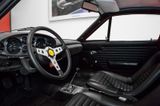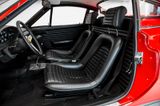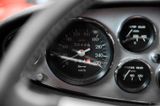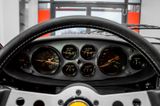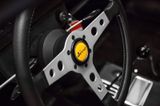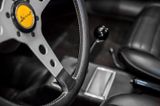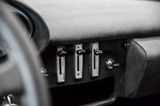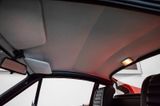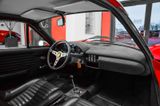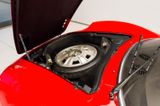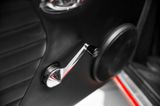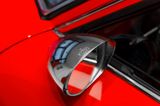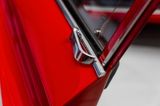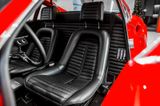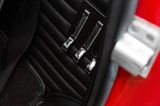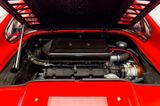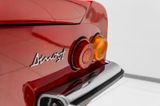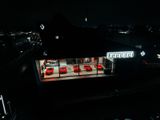Ferrari 246 GT Dino Series M (II) ~Ferrari Munsterhuis~
379 500 € (brutto)
Preis
379 500 € (brutto)
DPH nelze vrátit
9 574 785 Kč (brutto)
Technické údaje
Stav
Informace:
Vozidlo je považováno za nebourané pouze v případě, že prodejce může poskytnout závazné ujištění, že nikdy neutrpělo žádné (závažné) poškození při dopravní nehodě.Nebourané, Použité
KategorieSportsCar
Datum první registrace06/1970
PřevodovkaManuální
PalivoBenzín
Počet najetých km58 499 km
Výkon143 kW (194 PS)
Objem2 418 ccm
Počet sedadel2
Počet dveří2/3
BarvaČervená
Název barvy výrobceRosso
Stav vozidlaPoužité vozidlo, Nebourané
Informace:
Poškozená vozidla jsou vozidla s neopraveným vážným poškozením, např. následkem dopravní nehody, požáru, krupobití, povodní, s poškozením motoru nebo převodovky. Mezi poškozená vozidla nepatří vozidla s: 1.) běžným opotřebením; 2.) drobnějším poškozením; 3.) vozidla, která byla po nehodě opravena. Kromě toho lze vozidlo považovat za vozidlo bez nehody pouze v případě, že nebylo vážněji poškozeno při nehodě. tj. neutrpělo vážnější než drobné poškození (např. poškrábaný lak). I když bylo vozidlo řádně opraveno, nelze ho považovat za vozidlo bez nehody. A konečně, „pojízdné” znamená, že vozidlo je technicky způsobilé k jízdě (tj. nemá např. poškozený motor nebo podobnou závadu). Tento stav nereflektuje aspekty dopravní bezpečnosti nebo jiné způsobilosti vozidla.KategorieSportovní vůz / Kupé
OriginVerze pro EU
AntriebsartSpalovací motor
Typ interiéruCelé v kůži, Černá
Cylinder6
Výbava
Rear wheel drive
Úplná servisní historie
Vozidlo po nekuřákovi
Popis vozidla
Hereby we are selling this unique Classiche certified Dino 246GT.
New Delivered in Italy. 2016 Classiche certified.
The Dino 246 GT was an evolution of the Dino 206 GT, with a larger V6 engine and a wheelbase lengthened by 60 mm. Apart from the longer body, the design was virtually identical, with just a longer engine cover and a repositioned fuel cap. The car proved commercially very successful, and three series were produced during its life span. When production stopped in 1973-4 demand was still high.
At about the time that the Dino 206 GT gave way to its successor the 246 GT during 1969, Enzo Ferrari was reaching an agreement with Gianni Agnelli of Fiat to take over the production car side of the Ferrari business.
At this time Enzo Ferrari was already over 70 years of age, and apart from securing the long-term future of the production car business, it freed him from the day to day responsibilities of it, and gave him more time to devote to his first love, the racing department. The Dino 246 GT made its official debut at the Turin Show in November 1969, although the production run had already commenced. A total of 81 examples were completed by the end of the year.
Visually the 246 GT was almost identical to the 206 GT that it succeeded, apart from the fuel filler cap being under a flush fitting flap on the left sail panel. In reality there were more differences than initially met the eye. Apart from the increase in engine capacity from 2 litres to 2.4 litres, the engine block material was changed from aluminium to cast iron. Also not apparent from a casual glance was the change to the wheelbase, which was 2280mm on the 206 GT, and 2340mm on the 246 GT, with a corresponding increase in overall length. An increase in diameter of the paired twin exhaust pipes could also be noticed.
During the production period of the 246 GT from 1969 to 1974, there were no major changes to any features, although various smaller items and details did change, leading to the three series of cars referred to as “L”, “M” and “E”. This is apart from the different market versions, and the targa-roof 246 GTS model. Broadly speaking, series “L” cars were produced in late 1969 and through 1970.
They have road wheels with a single knock-off spinner, front quarter bumpers into the grille opening, rear licence plate lights in the quarter bumper ends, an external boot lid release button and head rests mounted on the rear bulkhead. The body material was steel with an aluminium front lid. Series “M” cars were produced for a short period in the early part of 1971. They had five bolt fixing for the road wheels, an internal rear boot lid release catch, seat-mounted headrests, plus detail changes to the engine and gearbox, whilst the chassis received modification, resulting in an increase of 30mm in the rear track.
For more information, please contact:
Rik Hettema r.hettema@munsterhuis.nl
Wouter Struik w.struik@munsterhuis.nl
Robin Schurink r.schurink@munsterhuis.nl
Or call +31 (0) 742555370 or come over to Hengelo
New Delivered in Italy. 2016 Classiche certified.
The Dino 246 GT was an evolution of the Dino 206 GT, with a larger V6 engine and a wheelbase lengthened by 60 mm. Apart from the longer body, the design was virtually identical, with just a longer engine cover and a repositioned fuel cap. The car proved commercially very successful, and three series were produced during its life span. When production stopped in 1973-4 demand was still high.
At about the time that the Dino 206 GT gave way to its successor the 246 GT during 1969, Enzo Ferrari was reaching an agreement with Gianni Agnelli of Fiat to take over the production car side of the Ferrari business.
At this time Enzo Ferrari was already over 70 years of age, and apart from securing the long-term future of the production car business, it freed him from the day to day responsibilities of it, and gave him more time to devote to his first love, the racing department. The Dino 246 GT made its official debut at the Turin Show in November 1969, although the production run had already commenced. A total of 81 examples were completed by the end of the year.
Visually the 246 GT was almost identical to the 206 GT that it succeeded, apart from the fuel filler cap being under a flush fitting flap on the left sail panel. In reality there were more differences than initially met the eye. Apart from the increase in engine capacity from 2 litres to 2.4 litres, the engine block material was changed from aluminium to cast iron. Also not apparent from a casual glance was the change to the wheelbase, which was 2280mm on the 206 GT, and 2340mm on the 246 GT, with a corresponding increase in overall length. An increase in diameter of the paired twin exhaust pipes could also be noticed.
During the production period of the 246 GT from 1969 to 1974, there were no major changes to any features, although various smaller items and details did change, leading to the three series of cars referred to as “L”, “M” and “E”. This is apart from the different market versions, and the targa-roof 246 GTS model. Broadly speaking, series “L” cars were produced in late 1969 and through 1970.
They have road wheels with a single knock-off spinner, front quarter bumpers into the grille opening, rear licence plate lights in the quarter bumper ends, an external boot lid release button and head rests mounted on the rear bulkhead. The body material was steel with an aluminium front lid. Series “M” cars were produced for a short period in the early part of 1971. They had five bolt fixing for the road wheels, an internal rear boot lid release catch, seat-mounted headrests, plus detail changes to the engine and gearbox, whilst the chassis received modification, resulting in an increase of 30mm in the rear track.
For more information, please contact:
Rik Hettema r.hettema@munsterhuis.nl
Wouter Struik w.struik@munsterhuis.nl
Robin Schurink r.schurink@munsterhuis.nl
Or call +31 (0) 742555370 or come over to Hengelo
Dealer tiráž
Munsterhuis Sportscars B.V.
Goudstraat 31-49
NL-7554 NG Hengelo Nizozemsko
- Telefonní číslo: +31 74 808 0795
S mobile.de od 5. 11. 2013
Ovládané jazyky:
Deutsch, English, Nederlands




